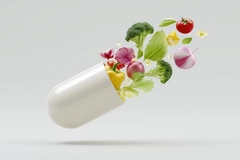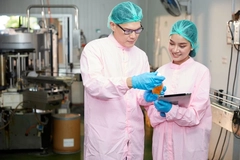Ayana Bio enhances ultra-processed foods with cultivated plant cells for health claims

The food industry is under increasing pressure to address the nutritional shortcomings of ultra-processed foods (UPFs), which plant cell culture technology can now address. Operating like microscopic biofactories, cultivated plant cells can be engineered to deliver bioactive compounds like polyphenols and carotenoids directly into these products to improve their ability to support cognition, cardiovascular health and antioxidant claims.
Despite their affordability and ease of use, UPFs’ general associations with disease risk factors and empty calories have increased demand for food products that balance nutrition and functionality.
Frank Jaksch, CEO of Ayana Bio, tells Nutrition Insight about how this approach could reshape the future of processed foods, making them healthier without compromising taste or accessibility.
What bioactive-rich ingredients can plant cell culture technology add to UPFs and how do they improve nutritional value?
Jaksch: Plant cell culture technology can produce healthy bioactives like polyphenols, flavonoids, antioxidants and carotenoids directly from plant cells. Unlike precision fermentation which yields a single compound, plant cell culture can produce the full spectrum of bioactives found in the plant, which is ultimately a better tool for improving nutrient density. Plants were designed by nature to produce this rich mixture of bioactives, and plant cell culture allows us to deliver this synergistic nutritional density in a more controlled and sustainable way.
These compounds can be incorporated into ultra-processed foods (UPFs) to enhance their nutritional value. Bioactives support health by addressing nutritional gaps and potentially resolving key nutrient deficiencies contributing to declining public health. For example, anthocyanins from blueberries can be cultivated using plant cell culture and added to UPFs to promote brain health, cardiovascular support and anti-inflammatory benefits. This method avoids the sugar or distinct taste profiles associated with whole blueberries while preserving taste and shelf stability. Integrating concentrated nutrients would make UPFs more functional and health-promoting. Imagine a macaroni and cheese with the full equivalent of a serving of broccoli without impacting the consumer experience in taste and texture.
How does the cost of using plant cell culture compare to traditional methods, and can it make UPFs affordable?
Jaksch: Plant cell culture technology is increasingly cost-competitive due to advancements in bioprocess optimization and scalability. It eliminates the need for land, pesticides and lengthy growing cycles, reducing the time and costs associated with traditional agriculture. We believe that we can scale our plant cell-derived ingredients using or partnering with existing contract manufacturing organizations to leverage existing capacity. Additionally, plant cell culture enables precise nutrient customization, allowing manufacturers to produce high-quality ingredients efficiently. As the technology scales, it has the potential to make fortified UPFs affordable for institutions like schools and low-income communities, broadening access to enhanced nutrition. Frank Jaksch, CEO of Ayana Bio.
Frank Jaksch, CEO of Ayana Bio.
What challenges do you foresee in scaling this technology for mass production and adoption by major food manufacturers?
Jaksch: New innovative tools like plant cell-derived ingredients are necessary to improve nutrient density and bring health benefits to make UPFs healthy again. And scaling plant cell culture technology for mass production and adoption by major food manufacturers comes with challenges that can be addressed through collaboration and innovation. From the beginning, we set out to develop plant cell-derived ingredients that would be capable of achieving a scale that would effectively meet the demands of the food companies we aim to serve. We also targeted a cost that was advantageous compared to incumbent agricultural-derived materials. At the same time, it was necessary to form partnerships with CMOs and food manufacturers to integrate plant cell-derived bioactives into supply chains. These partnerships can demonstrate how plant cell technology creates a cost-effective and sustainable supply chain independent of weather disruptions and climate change.
How do you address skepticism that adding nutrients to UPFs might not compensate for their health risks, such as high sugar and fat content?
Jaksch: UPFs are often necessary for delivering cost-effective, shelf-stable food options to populations with limited time or resources. Addressing skepticism requires a two-pronged approach. First, the industry must take a reduction approach to reduce unhealthy ingredients like fats, sugars, empty calories, artificial colors and synthetic preservatives. The second approach is fortification with nutrient-dense ingredients that bring health benefits back to UPFs. This second approach requires innovative tools for adding nutrients to the products and plant cell culture is one of the solutions.
As the industry transforms itself for the future of health, transparency is needed to demonstrate that plant cell-derived bioactives are not just “nutrient patches” but integral to creating cleaner, more functional foods. Clinical evidence demonstrating the health benefits of the bioactives will further build trust and educate consumers. Ultimately, the goal is to transform UPFs into vehicles for essential nutrition, not just sources of empty calories.
What role should policies play in promoting or regulating plant cell culture technology in food innovation?
Jaksch: First, the government will play a key role in defining and implementing restrictions on what should or should not be included in processed foods. However, there also needs to be a willingness from the large food companies to improve and reformulate processed foods by limiting unhealthy additives and, more importantly, embracing the inclusion of nutrient-dense health-beneficial ingredients. Even if governments implement regulations for processed foods, meaningful change won’t happen without the support of large food companies.
Governments can play a pivotal role in fostering the adoption of plant cell culture by offering grants or tax incentives to companies developing technologies to improve the nutrient density of today’s food systems. For example, last year, Ayana Bio received a grant from the NIH to develop plant cell saffron, which signals that the government is taking an interest in innovative technologies like plant cell cultivation.
 Plant cell culture technology can produce healthy bioactives like polyphenols, flavonoids, antioxidants and carotenoids directly from plant cells.Additionally, we must navigate existing government regulatory processes to obtain the notification necessary for food, beverage, and dietary supplement companies to use plant cell-derived ingredients. Plant cell-derived ingredients have already been approved in the EU. We have also met with the US FDA, and the existing GRAS and NDI regulations should allow for plant cell-derived ingredients. We believe the approach used with EFSA in the EU will pave the way for approvals in the US.
Plant cell culture technology can produce healthy bioactives like polyphenols, flavonoids, antioxidants and carotenoids directly from plant cells.Additionally, we must navigate existing government regulatory processes to obtain the notification necessary for food, beverage, and dietary supplement companies to use plant cell-derived ingredients. Plant cell-derived ingredients have already been approved in the EU. We have also met with the US FDA, and the existing GRAS and NDI regulations should allow for plant cell-derived ingredients. We believe the approach used with EFSA in the EU will pave the way for approvals in the US.
UPFs under fire
With Donald Trump’s return as US President, a law firm forecasts increased attention will be paid to UPFs, front-of-package nutrition labels and healthy diets.
California’s governor gave an executive order to agencies to crack down on UPFs and food dyes and to expand access to affordable, nutritious school meals in the US state.
The 2025 Dietary Guidelines Advisory Committee’s report recently expanded its analysis, suggesting that more nutrient-dense plant-based meals be included and outlining details on diary patterns and UPFs in the dietary recommendations.
Other research has linked high UPF consumption to higher fat inside thigh muscles. Recent research has warned over half of US adults’ calorie consumption comes from UPFs, while other studies link UPFs with accelerated biological aging next to increased colorectal cancer and non-communicable diseases.












